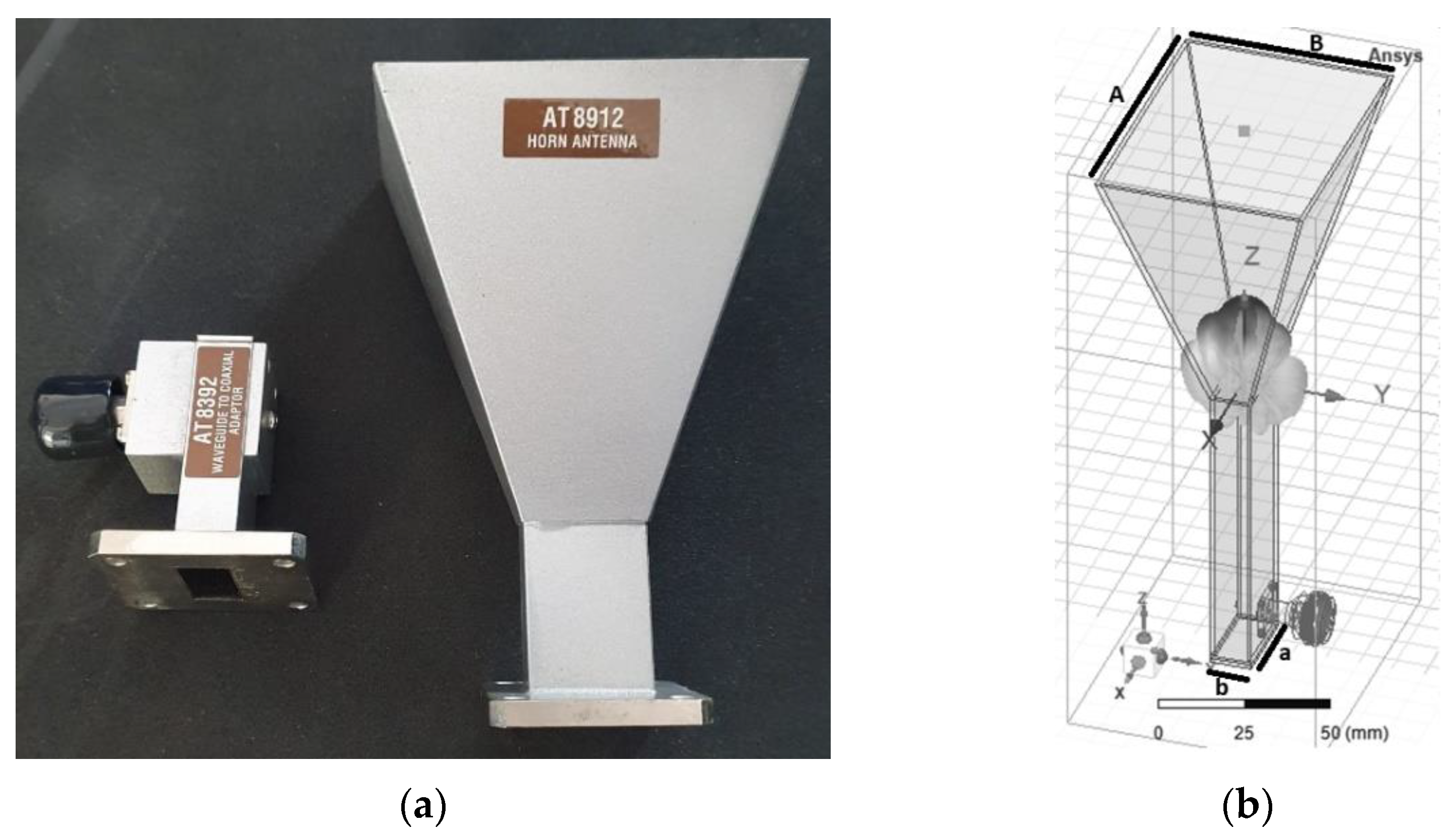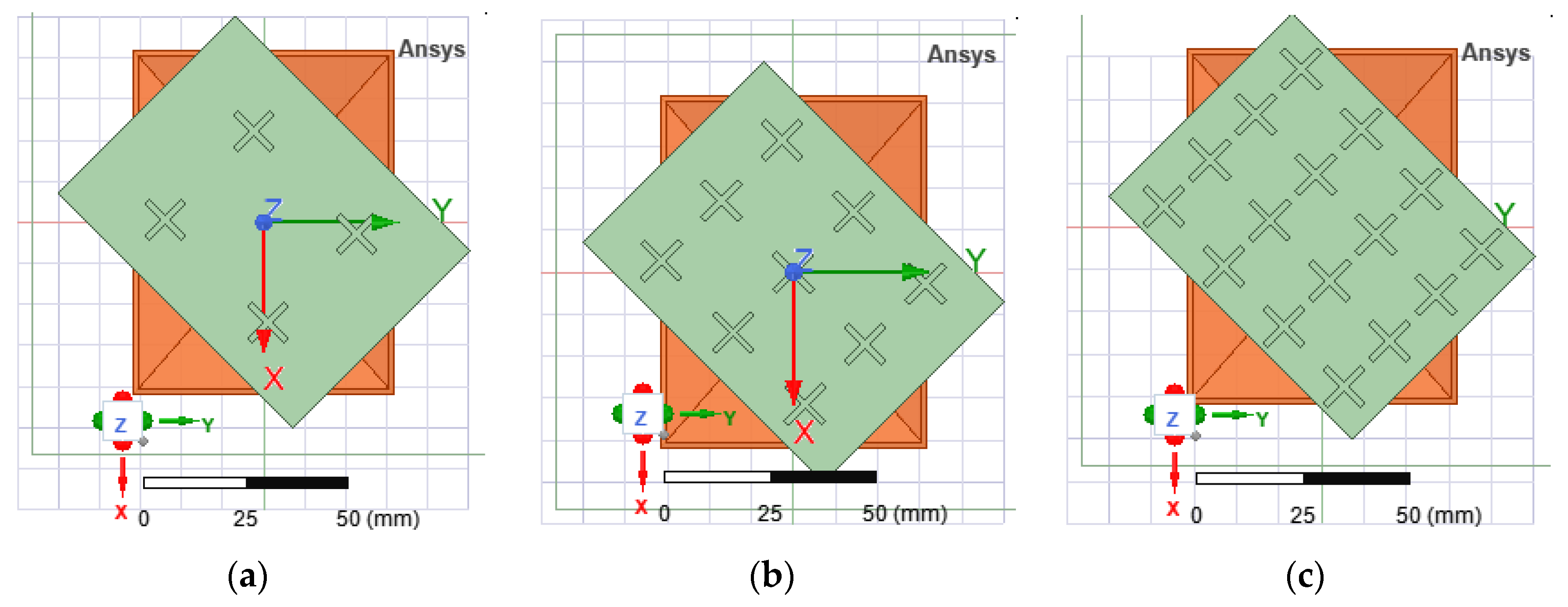Transforming Linear to Circular Polarization on Horn Antennas by Using Multiple-Layer Frequency Selective Surfaces
Abstract
:1. Introduction
2. Transforming Wave Polarization Using Arrays of Passive Radiators
2.1. Generating a Dual Polarization Using a Linear Radiator Tilted with Respect to the Direction of the Incident Electric Field
2.2. FSS Unit Cells Potentially Usable as Polarization Transformers
3. Converting a Pyramidal Horn Antenna into a Circularly Polarized Antenna
3.1. Analysis of the Original Pyramidal Horn Antenna
3.2. Radiating Systems with Circular Polarization Consisting of a Horn Antenna and FSS Layers
3.2.1. FSS Structure with N × N Cross-Shaped Elements
3.2.2. Multiple-Layer FSS Structures
3.3. Simulation and Measurement Results
3.3.1. Input Reflection Coefficient
3.3.2. Radiation Patterns
3.3.3. Polarization
4. Conclusions
Author Contributions
Funding
Institutional Review Board Statement
Informed Consent Statement
Data Availability Statement
Conflicts of Interest
References
- Nadeem, I.; Alibakhshikenari, M.; Virdee, B.S.; Babaeian, F.; Althuwayb, A.A.; Azpilicueta, L.; Huynen, I.; Falcone, F. A comprehensive survey on “Circular Polarized Antennas” for existing and emerging wireless communication technologies. J. Phys. D Appl. Phys. 2021, 55, 033002. [Google Scholar] [CrossRef]
- Meher, P.R.; Behera, B.R.; Mishra, S.K.; Alibakhshikenari, A.A. A chronological review of circularly polarized dielectric resonator antenna: Design and developments. Int. J. RF Microw. Comput.-Aided Eng. 2021, 31, e22589. [Google Scholar] [CrossRef]
- Gaya, A.; Jamaluddin, M.H.; Ali, I.; Althuwayb, A.A. Circular Patch Fed Rectangular Dielectric Resonator Antenna with High Gain and High Efficiency for Millimeter Wave 5G Small Cell Applications. Sensors 2021, 21, 2694. [Google Scholar] [CrossRef] [PubMed]
- Le, T.T.; Tran, H.H.; Althuwayb, A.A. Wideband circularly polarized antenna based on a non-uniform metasurface. Appl. Sci. 2020, 10, 8652. [Google Scholar] [CrossRef]
- Alibakhshikenari, M.; Ali, E.M.; Soruri, M.; Dalarsson, M.; Naser-Moghadasi, M.; Virdee, B.S.; Stefanovic, C. A Comprehensive Survey on Antennas On-Chip Based on Metamaterial, Metasurface, and Substrate Integrated Waveguide Principles for Millimeter-Waves and Terahertz Integrated Circuits and Systems. IEEE Access 2021, 10, 3668–3692. [Google Scholar] [CrossRef]
- Gao, S.S.; Luo, Q.; Zhu, F. Circularly Polarized Antennas; Wiley-IEEE: Hoboken, NJ, USA, 2014. [Google Scholar]
- Wahid, A.; Munir, A.; Chairunnisa. Dual Polarization X-Band Square Horn Antenna. In Proceedings of the International Conference on Telecommunication Systems Services and Applications, Denpasar, Indonesia, 6–7 October 2016. [Google Scholar]
- Heiman, A.; Badescu, A. Circularly Polarized Pyramidal Horn Antenna for Ku Band. In Proceedings of the IEEE International Conference on Wireless for Space and Extreme Environments, Vicenza, Italy, 12–14 October 2020; pp. 45–48. [Google Scholar]
- Bhardwaj, S.; Volakis, J.L. Hexagonal Waveguide Based Circularly Polarized Horn Antennas for Sub-mm-Wave/Terahertz Band. IEEE Trans. Antennas Propag. 2018, 66, 3366–3374. [Google Scholar] [CrossRef]
- Shi, H.; Chen, J.; Zhang, A.; Jiang, Y. Design of a Circular Polarized Horn Antenna with an Anisotropic Metamaterial Slab. J. Freq. 2010, 67, 271–276. [Google Scholar] [CrossRef]
- Zhang, F.; Yang, G.M.; Jin, Y.Q. Linear to circular polarization converter with third order meta-frequency selective surfaces. In Proceedings of the Asia-Pacific Conference on Antennas and Propagation, Xi’an, China, 16–19 October 2017; pp. 1–3. [Google Scholar]
- Shu, C.; Wang, J.; Yao, S.; Yu, J.; Alfadhl, Y.; Chen, X. A Wideband Dual-Circular-Polarization Horn Antenna for mmWave Wireless Communications. IEEE Antennas Wirel. Propag. Lett. 2019, 18, 1726–1730. [Google Scholar] [CrossRef]
- Wang, L.J.; Gao, X.; Yu, F.L. A Compact and Broadband Circularly Polarized Horn Antenna. In Proceedings of the IEEE International Conference on Computational Electromagnetics, Chengdu, China, 26–28 March 2018; pp. 1–3. [Google Scholar]
- Munk, B.A. Frequency Selective Surfaces: Theory and Design; Wiley: New York, NY, USA, 2000. [Google Scholar]
- Wang, Y.; Yuan, Y.; Yang, G.; Ding, X.; Wu, Q.; Jiang, Y.; Burokur, S.N.; Zhang, K. Perfect Control of Diffraction PatternswithPhase Gradient Metasurfaces. ACS Appl. Mater. Interfaces 2022, 14, 16856–16865. [Google Scholar] [CrossRef]
- Li, L.; Li, Y.; Wu, Z.; Huo, F.; Zhang, Y.; Zhao, C. Novel polarization reconfigurable converter based on multilayer frequency selective surfaces. Proc. IEEE 2015, 103, 1057–1070. [Google Scholar] [CrossRef]
- Naseri, P.; Matos, S.A.; Costa, J.R.; Fernandes, C.A.; Fonseca, N.J.G. Dual-band dual-linear-to-circular polarization converter in transmission mode application to K/Ka-band satellite communications. IEEE Trans. Antennas Propag. 2018, 60, 7128–7136. [Google Scholar] [CrossRef] [Green Version]
- Martinez-Lopez, L.; Rodriguez-Cuevas, J.; Martinez-Lopez, J.I.; Martynyuk, A.E. A multilayer circular polarizer based on bisected splitring frequency selective surfaces. IEEE Antennas Wirel. Propag. Lett. 2014, 13, 153–156. [Google Scholar] [CrossRef]
- Ge, Y.H.; Lin, C.X.; Liu, K.T. Circularly polarized horns based on standard horns and a metasurface polarizer. IEEE Antennas Wirel. Propag. Lett. 2018, 17, 480–484. [Google Scholar] [CrossRef]
- Jazi, M.N.; Chaharmir, M.R.; Shaker, J.; Sebak, A.R. Broadband transmitarray antenna design using polarization-insensitive frequency selective surfaces. IEEE Trans. Antennas Propag. 2016, 64, 99–108. [Google Scholar] [CrossRef]
- Hsu, C.; Hwang, L.; Lee, P.; Wang, S.; Chang, F. Design of a High Gain and Dual polarized Transmitarray Using FSS of Smaller Unit Cells. In Proceedings of the International Symposium on Antennas and Propagation, Okinawa, Japan, 24–28 October 2016; pp. 776–777. [Google Scholar]
- Luo, G.Q.; Hong, W.; Tang, H.J.; Chen, J.X.; Yin, X.Y.; Wu, K.; Kuai, Z.Q. Filtenna Consisting of Horn Antenna and Substrate Integrated Waveguide Cavity FSS. IEEE Trans. Antennas Propag. 2007, 55, 92–98. [Google Scholar] [CrossRef]
- Badreldin, A.; Allam, A.M.M.A. Effect of Loading a Horn Antenna with a Double Square Loop FSS “Filtenna System”. Int. J. Comput. Inf. Technol. 2013, 2, 981–985. [Google Scholar]
- Tahseen, H.U.; Yang, L.; Zhou, X. Design of FSS-antenna-radome system for airborne and ground applications. IET Commun. 2021, 5, 1691–1699. [Google Scholar] [CrossRef]
- Yang, C.; Zhu, X.W.; Liu, P.; Hong, W.; Feng, H.; Shi, Y. A Circularly Polarized Horn Antenna Based on FSS Polarization Converter. IEEE Antenna Wirel. Propag. Lett. 2019, 19, 277–281. [Google Scholar] [CrossRef]
- Yin, J.Y.; Wan, X.; Ren, J.; Cui, T.J. A Circular Polarizer with Beamforming Feature Based on Frequency Selective Surfaces. Sci. Rep. 2017, 7, 41505. [Google Scholar] [CrossRef] [Green Version]
- Pan, W.; Huang, C.; Chen, P.; Pu, M.; Ma, X.; Luo, X. A Beam Steering Horn Antenna Using Active Frequency Selective Surface. IEEE Trans. Antennas Propag. 2013, 61, 6218–6223. [Google Scholar] [CrossRef]
- Surmeli, K.; Kizilay, A. Design of slant polariser for directionalantennas and antenna arrays. IET Microw. Antennas Propag. 2019, 13, 1546–1553. [Google Scholar] [CrossRef]
- Cao, X.; Gong, Z.; Yi, Y.; Wang, B.; Wan, X. Design of a Dual-Polarized Yagi-Uda Antenna for the Passive Radar. In Proceedings of the International Symposium on Antennas, Propagation and EM Theory, Guilin, China, 18–21 October 2016; pp. 125–128. [Google Scholar]






















| Number of Elements of the FSS Structure, N × N | Overall Gain, G [dB] | Gain Difference between Types Circular Polarization, GRHCP − GLHCP [dB] | Axial Ratio |
|---|---|---|---|
| 2 × 2 | 5.2 | 0.3 | 58 |
| 3 × 3 | 11.34 | 1.74 | 10 |
| 4 × 4 | 13.02 | 2.3 | 7 |
| 5 × 5 | 12.7 | 2.8 | 6 |
| 6 × 6 | 8.64 | 2.36 | 7.38 |
| 7 × 7 | 12 | 2.5 | 6.86 |
| Vibrator (Horn Aperture) | Director 1 | Director 2 | Director 3 | Director 4 | Director 5 | |
|---|---|---|---|---|---|---|
| Position [mm] | 0 | 2 | 6 | 12 | 18 | 25 |
| Ref. # | FSS Structure Type (Figure 11) | Number of Layers | Radiator Width [mm] | Overall Gain, G [dBi] | Gain Difference between Types of Circular Polarization, GRHCP − GLHCP [dB] | Axial Ratio | Gain Difference between Types of Linear Polarization, Gco – Gcross [dB] | Dominant Circular Polarization |
|---|---|---|---|---|---|---|---|---|
| 1 | “\”, left tilted | 5 | 1.5 | 12.5 | 21.32 | 1.19 | 1.36 | RHCP |
| 1 | 1.5 | 10.6 | 4.1 | 4.24 | 10.27 | RHCP | ||
| 2 | 3 | 2 | 12.6 | 18 | 1.28 | 0.9 | RHCP | |
| 1 | 2 | 12 | 4 | 3.66 | 10 | RHCP | ||
| 3 | “\”, right tilted | 5 | 1.5 | 12,5 | 21 | 1,19 | 1.43 | LHCP |
| 1 | 1.5 | 12.2 | 4 | 4.31 | 11.3 | LHCP | ||
| 4 | “/”, left tilted | 3 | 2.5 | 13.2 | 13.08 | 1.56 | 3.92 | LHCP |
| 1 | 2.5 | 11.2 | 3.5 | 5.15 | 12.8 | LHCP | ||
| 5 | 4 | 3 | 12 | 15.77 | 1.38 | 2.14 | LHCP | |
| 1 | 3 | 10.9 | 4 | 4.47 | 12.5 | LHCP | ||
| 6 | “/”, right tilted | 4 | 3 | 11.4 | 16 | 1.38 | 1.8 | RHCP |
| 1 | 3 | 12.3 | 4 | 4.46 | 12 | RHCP | ||
| 7 | 4 | 2.5 | 12.4 | 11.13 | 1.76 | 2.18 | RHCP | |
| 1 | 2.5 | 8.3 | 3 | 5.19 | 14 | RHCP | ||
| 8 | “+”, left tilted | 5 | 3 | 12.2 | 12 | 1.67 | 2.42 | RHCP |
| 1 | 3 | 10.6 | 3 | 5.9 | 12.3 | RHCP | ||
| 9 | “+”, right tilted | 5 | 2.5 | 12.5 | 10.56 | 1.84 | 4.37 | LHCP |
| 1 | 2.5 | 6.1 | 2.5 | 7 | 15 | LHCP | ||
| 10 | 4 | 3 | 11.73 | 11.4 | 1.73 | 4.77 | LHCP | |
| 1 | 3 | 1.85 | 2 | 5.69 | 11 | LHCP |
| Ref. # | FSS Structure | Number of layers | Radiator Width [mm] | Overall Gain, G * [dBi] | Gain Difference between Types of Circular Polarization, GRHCP − GLHCP [dB] | Axial Ratio * | Gain Difference between Types of Linear Polarization, Gco – Gcross * [dB] | Dominant Circular Polarization |
|---|---|---|---|---|---|---|---|---|
| (a) |  | 4 | 3 | 12/13.28 | 15.77 | 1.38/ 1.22 | 2.14/ 1.22 | LHCP |
| (b) |  | 5 | 1.5 | 12.5/13.53 | 21.32 | 1.19/ 1.4 | 1.36/ 2 | RHCP |
| (c) | 3 | 2 | 12.6/13.62 | 18 | 1.28/ 2.5 | 0.9/ 3.5 | RHCP | |
| (d) |  | 5 | 3 | 12.2/ 13.72 | 12 | 1.67/ 2 | 2.42/ 0.6 | RHCP |
Publisher’s Note: MDPI stays neutral with regard to jurisdictional claims in published maps and institutional affiliations. |
© 2022 by the authors. Licensee MDPI, Basel, Switzerland. This article is an open access article distributed under the terms and conditions of the Creative Commons Attribution (CC BY) license (https://creativecommons.org/licenses/by/4.0/).
Share and Cite
Heiman, A.; Tamas, R.D. Transforming Linear to Circular Polarization on Horn Antennas by Using Multiple-Layer Frequency Selective Surfaces. Sensors 2022, 22, 7838. https://doi.org/10.3390/s22207838
Heiman A, Tamas RD. Transforming Linear to Circular Polarization on Horn Antennas by Using Multiple-Layer Frequency Selective Surfaces. Sensors. 2022; 22(20):7838. https://doi.org/10.3390/s22207838
Chicago/Turabian StyleHeiman, Adelaida, and Razvan D. Tamas. 2022. "Transforming Linear to Circular Polarization on Horn Antennas by Using Multiple-Layer Frequency Selective Surfaces" Sensors 22, no. 20: 7838. https://doi.org/10.3390/s22207838







